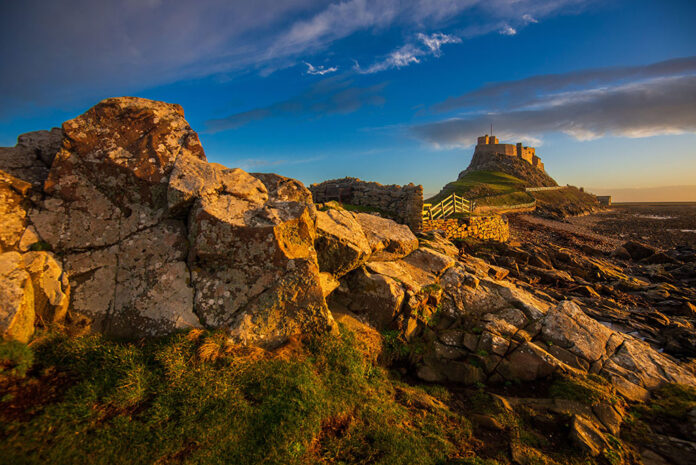
Once the holiest site in Anglo-Saxon England, the beautiful tidal island of Lindisfarne is a haven for historians
Driving over the Lindisfarne causeway from the English mainland is one of the most memorable experiences you can have in Britain. From the moment you see the small tidal island for the first time from the Northumberland coast, with its majestic castle reigning supreme at one end, you’ll be in no doubt that Lindisfarne is one of the country’s most beautiful spots.
The island is easily accessible via road, although it’s cut off from the mainland twice a day during high tide (planning is essential to avoid being stranded). Once on the island you feel an age away from normal life. Most visitors come just for the day, so if you choose to stay longer you get a wonderful sense of having the entire island to yourself, apart from the friendly locals and the colonies of seals, of course.
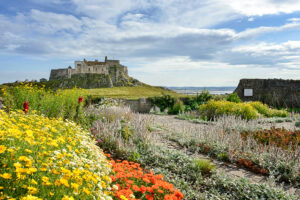
Also known as ‘Holy Island’, Lindisfarne was once the most sacred site in Anglo-Saxon England. St Aidan, an Irish monk from Iona, the centre of Christianity in Scotland, was invited by Oswald, the King of Northumbria, to convert his kingdom to Christianity. St Aidan founded Lindisfarne Monastery on Holy Island in 635 AD.
In the 670s, a monk named Cuthbert joined the monastery, and went on to become the most important northern English saint in the Middle Ages. Cuthbert lived as a hermit on a rock just off the beach by the Priory (visitors can easily walk to St Cuthbert’s Isle from the beach when the tide is out), before later moving to the remote island of Inner Farne.
When he died in 687 Cuthbert was buried in a stone coffin on the island, and eleven years later the monks opened his tomb and discovered that his body had not decayed. So began the cult of St Cuthbert, with miracles being reported at his shrine, and Lindisfarne became a major centre of pilgrimage. The monastery grew in power and wealth and became a hub of Christian learning, resulting in the production in the 8th century of the illuminated Latin manuscript, the Lindisfarne Gospels, now housed in the British Library.
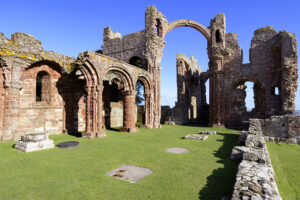
Its wealth meant that Lindisfarne Priory became a target for Viking raiders from the end of the 8th century. In fact, the attack on Lindisfarne on 8 June 793 AD is believed to be the first significant Viking attack in western Europe.
The monks abandoned the monastery and did not return for 400 years. In the 12th century it became an active religious site again, but was closed in 1537 during the Dissolution of the Monasteries. By the 18th century the Priory was in ruins, though it has remained a centre of pilgrimage.
Now looked after by English Heritage, Lindisfarne Priory has an excellent museum, with a brand-new display of never-before-seen Christian and Anglo-Saxon artefacts, including the first known rosary bead necklace, made from salmon vertebrae and found on a skeleton from Lindisfarne.
The island has its very own castle too. Despite being much smaller than the magnificent Bamburgh Castle, to which it looks out to over the causeway, Lindisfarne Castle has the same proud stance on its rocky island outcrop, and looks nothing short of magnificent at sunset.
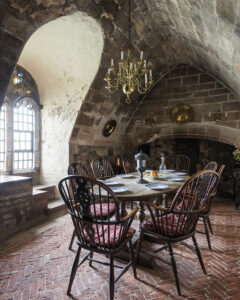
The castle was originally a 16th-century fort, and in 1901 Edward Hudson, the founder of Country Life magazine, took over the lease and commissioned the architect Edwin Lutyens and garden designer Gertrude Jekyll to work their magic. It is now a wonderful example of an Arts and Crafts house, with its original Elizabethan features carefully preserved.
No trip to the island is complete without a walk along the Lindisfarne National Nature Reserve, which, in addition to stunning stretches of beaches and dunes, is home to an abundance of protected wildlife, from wildfowl and wading birds to grey seals, which can regularly be spotted sunbathing on the sands. Keen walkers can walk around the entire island in around three hours.
If you’re in the market for a Holy Island souvenir, it doesn’t get more special than a bottle of Lindisfarne Mead. Although the island’s monks have been gone for 500 years, the mead that they perfected (a unique twist on traditional mead, using grapes blended with fermented honey) is still produced at St Aidan’s Winery on the island to an ancient recipe, infused in pure water drawn from the island’s ancient well.
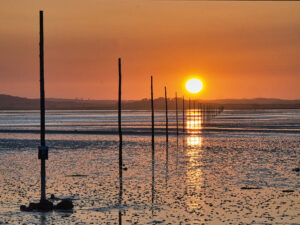
The result is a warming and delicious tipple that will leave you longing for another trip to this special place, where thousands of years of history seem to live on all around you.
This is an extract, read the full version in the May/June issue of BRITAIN, available to buy here from 7 April.
Read more:





 © 2024
© 2024